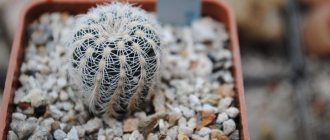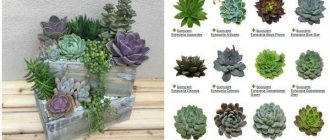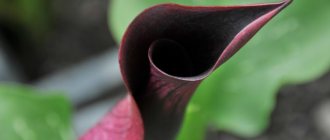Photo of a blooming Epiphyllum (Epiphyllum) is a beautifully flowering succulent from the Cactus family. In indoor culture it is grown as an hanging plant. Characterized by long, branched stems with flat or triangular edges. The flowers are large, funnel-shaped. It is also called phyllocactus.
At the base they are covered with small scales and spines. In nature it develops as an epiphyte; in indoor conditions it grows well on a substrate. Epiphyllum is native to tropical and subtropical regions of South America.
Also be sure to see how to grow prickly pear indoors.
| Average growth rate. |
| Blooms in spring and summer. |
| The plant is easy to grow indoors. |
| Perennial. |
Beneficial features
Epiphyllum oxypetalum.
Photo The fleshy fruits of phyllocactus can be eaten. Their healing properties were already known to the indigenous Indians. In folk medicine, the juice and leaves of the Dreamland epiphyllum variety are used to treat psoriasis and as an intestinal cleanser.
Main types
The genus Epiphyllum has more than 20 species. Here are some of them:
- Ackerman. It has red flowers located on thin stalks. It is usually grown by hanging it in a pot.
- Guatemalan. There are 2 varieties of it, which differ from each other in the shape of the stems. Leaves are 5 cm long.
- Just Prue. Easily adapts to the external environment and prefers a temperature of +18 °C. With pink flowers. Propagated by cuttings.
- Jagged. This species has no needles. It has several hybrids with different shades. Blooms at night.
- Lau. Characterized by dynamic growth and development. There are yellow-brown needles all over its surface.
- Oxypetalum. It has the appearance of a bush and reaches impressive sizes. The diameter of its flowers is 18 cm.
- Sharp-petalled. Otherwise, this species is called “white” because of the color of its flowers. It is preferable to grow it in a pot.
- Thomas. Its stems can reach 4 m in length, but at home they grow only up to 70 cm. Its shape resembles a bush with white flowers.
- Angular. The shape of its stems is zigzag, which justifies its name. The primary stems are round in shape and capable of lignification, while the secondary stems are flat and can reach up to 1 m in length.
- Phyllanthus. Flowering begins in mid-summer. Capable of producing single pink buds.
- Hooker. It has tough stems and grows to impressive sizes. With white flowers with pointed petals.
Features of growing at home. Briefly
Epiphyllum is grown quite simply at home:
| Temperature | Room temperature in summer, +13-15° in winter. |
| Air humidity | Needs periodic spraying. |
| Lighting | Bright, diffused, without direct sunlight. |
| Watering | Abundant in summer, 1-2 times a month in winter. |
| Priming | Light, fertile with mandatory drainage. |
| Feeding and fertilizer | During the period of intensive growth, once every 2 weeks. |
| Transfer | As it grows in the spring. |
| Reproduction | Cuttings and sowing seeds. |
| Features of cultivation | During the flowering period, the plant should not be rotated. |
Selecting dishes and soil for planting
For proper growing season and beautiful flowering, the pot in which the cactus is grown is of great importance. When choosing a container, take into account the size of the plant and its tendency to grow upward. Adult flowers are transplanted at the age of 3-4 years only after the roots grow from below in the pot through the drainage holes. For young specimens, the soil is changed annually.
Pot size
The cactus does not have a very large rhizome, so it prefers shallow containers. In order for epiphyllium to bloom actively, the pot must be too small for its rhizome. This stimulates the flower to form buds. When replanting overgrown specimens, take flowerpots that are 2-4 cm larger than the previous ones.
If the rhizome of the plant is well developed, then it is better to choose deep containers for planting.
Utensil shape
Many gardeners try to grow cacti in rectangular containers so that as many pots as possible can fit on the windowsill. But this approach is wrong, since the close arrangement of plants prevents free air circulation. This can lead to root rot due to moisture disturbance. Therefore, for epiphyllum it is better to take a round pot.
Substrate for epiphyllum plants
To grow cactus, it is best to buy ready-made soil. You can also prepare the substrate yourself. To do this, you will need 4 volumes of turf and leaf soil, as well as 1 volume of peat, river sand and charcoal. These five components will need to be mixed thoroughly. If everything is done correctly, the soil will be loose and breathable.
Epiphyllum: care at home. Details
Caring for epiphyllum at home should be carried out in compliance with certain rules.
Bloom
The flowering period of leaf cactus occurs at the end of spring - beginning of summer. Mature, well-developed plants are abundantly covered with large, fragrant flowers of white, red or pink. Each flower lasts about 5 days.
How to stimulate flowering
To stimulate the flowering of epiphyllum, all old shoots are cut out on the plant in the fall. If it was kept at high temperatures in winter, another pruning is carried out in the spring.
During pruning, all thin and elongated shoots are removed.
Temperature
Epiphyllum is grown at a temperature of +23-25°. With the beginning of autumn, the temperature must be reduced to +15°. It winters well even at +5°, so if you have an insulated loggia or veranda, you can take it there.
Spraying
Homemade epiphyllum adapts perfectly to the ambient air humidity. But if the temperature in the room rises above +26°, the plant must be sprayed daily. Spraying is also necessary during the period of intensive growth of leaf mass and during flowering.
Lighting
Bright but diffuse lighting is necessary. Windows facing east or west are best suited for growing it. You can grow a succulent from the north side, but in this case the flowering will be weak.
In order for the bush to develop evenly, the pot with the plant must be turned periodically. However, this should not be done once buds begin to form and during flowering. All the flowers may simply fall off.
Watering
In summer, water regularly and abundantly. But at the same time, the soil surface should dry out a little between waterings. In winter, the plant is watered very rarely. Usually 1-2 times a month is enough. When the temperature drops to +5°, watering is stopped completely.
Pot
The epiphyllum plant is grown indoors in spacious plastic or ceramic containers. The main thing is that drainage holes are made in their bottom. Despite the fact that it loves moisture, stagnation of moisture is destructive for it.
Priming
To grow epiphyllum, light, fertile soil is used. To compose the soil mixture, humus, turf soil and sand are used, they are taken in equal proportions. An industrial substrate for cacti is also suitable for growing. Before use, it is mixed with peat in a 1:1 ratio.
Feeding and fertilizer
During the period of intensive growth and during flowering, feed every 2 weeks.
For fertilizing, choose fertilizers with a high content of phosphorus and potassium; nitrogen is harmful to it.
Transfer
Epiphyllum is transplanted after the end of the flowering period. The plant is first allowed to rest for a month and only then replanting begins. Young, intensively growing specimens are replanted annually. Older plants as they grow, every 2-3 years.
Trimming
Epiphyllum needs constant pruning. It is carried out in the fall, before the start of the dormant period. All woody, crooked and damaged shoots are removed from the plant. Moderation should be observed when pruning. Buds are formed only on last year's shoots.
Rest period
For abundant flowering, epiphyllum requires a period of rest. Plants kept warm also bloom, but not as long and profusely. The dormant period lasts from late October to February.
During this period they are kept at +10-12°.
Indoor Epiphyllum: flower description
The Epiphyllum genus includes about 20 species. These plants belong to the Cactus family, and in nature they lead an epiphytic lifestyle, growing on the branches and trunks of trees in the tropics and subtropics of the American continent, as well as Mexico.
Epiphyllum is sometimes called Phyllocactus or Phyllocereus. A distinctive feature of this plant is its long, fleshy, cascading stems, which, depending on the type of cactus, can be flat, triangular or zigzag. Over time, the base of the stem begins to become woody and covered with brown bark.
For its magnificent flowering, Epiphyllum was dubbed the orchid cactus. This cactus blooms in spring and summer, very profusely, with large fragrant flowers, and under the sepals there are real leaves, which in appearance are more like spines. The buds are funnel-shaped with many petals. They appear at the ends of stems and can bloom at any time of the day. The color of the orchid cactus petals can be white, vanilla yellow, hot pink and scarlet.
In nature, after pollination, large edible fruits are formed in place of the buds, the color of which depends on the color of the bud itself. At home, cactus fruiting can only be achieved through cross-pollination.
Epiphyllum is grown in modern homes as an ampel plant. Its succulent stems can grow several meters and therefore require periodic pruning. At home, the forest cactus can be placed on a windowsill, table, stand or in a hanging pot to fully enjoy the unusual appearance and beauty of the flowering of this plant.
Growing epiphyllum from seeds
Like the vast majority of other succulents, it is easy to grow from seed. They are sown in the soil mixture without subsequent incorporation. To maintain high humidity, planting containers are covered with film and kept at a temperature of +25°. Crops must be ventilated periodically, removing accumulated condensate.
Shoots appear in 2-3 weeks. After this, the film is immediately removed. First, the seedlings acquire a faceted shape, which is not typical for epiphyllum; they will become flat after 3-4 months of cultivation. Plants grown from seeds bloom after 4-5 years.
How to prune Epiphyllum
Buds are formed only on old shoots from last year. In addition, Epiphyllum grows quickly and to maintain a neat appearance it will be necessary to carry out systematic pruning. Round or faceted branches should be cut out, as they usually do not bloom, and the length of flat shoots should be adjusted.
When cutting flat shoots, you need to be careful, since it is on such stems that flowers appear. Faded shoots will not produce flowers the next time, but they provide normal vital activity for the entire plant, so they can be pruned no sooner than after a couple of years.
The shoots are shortened only after flowering and before the start of hibernation. Shoots with corky growths are removed without regret, as well as all weak, twisted and damaged branches. After flowering, it is also necessary to remove wilted flowers, and all open and damaged areas are treated with crushed coal powder.
Propagation of epiphyllum by cuttings
The tops of well-developed last year's shoots are suitable for propagation. Cuttings 10-15 cm long are cut from them. Their base must be given a wedge-shaped shape. After this, the cuttings are dried for 2-3 days until a characteristic glassy crust forms on the cut. For planting, use clean sand or soil for succulents.
Cuttings are planted vertically to a depth of 1 cm. Plants grown from cuttings bloom the next year.
Cuttings can also be rooted above water. To do this, after drying, they are fixed in a container so that their lower part is as close as possible to the surface of the water. After the formation of root primordia, the cuttings are immediately planted in the substrate.
Bloom
Why doesn't the cactus bloom?
“Epiphyllum” will grow well under any conditions and does not require special care. The only problem is the flowering.
What to do if “Epiphylllium” does not bloom? In order for it to bloom with beautiful large flowers, special conditions are required.
Its flowering in summer depends on the conditions under which you keep Epiphyllum in winter. From November to February the plant is in a dormant period.
Tip: be sure to keep it in a cool room, at a temperature no higher than 12 degrees.
Of course, finding a cold and at the same time bright place in an apartment is not easy. Place it close to the window. Protect it from the batteries with a protective screen.
Do not fertilize at this time and reduce watering to a minimum. The soil should not dry out, but should not be wet either. Compliance with these conditions is necessary for the formation of flower buds.
How to make it bloom?
This can only be done by knowing some tricks and following the rules:
- At the end of February, the plant actively begins to form buds. At this time, you cannot move or even rotate it. This will cause the flower to drop its buds.
- March is the time to increase watering. The soil in the pot should be kept moist all the time.
- Flowers are formed only on fresh thickened shoots, and each areole blooms once. All old shoots must be removed.
- This species blooms only when grown in a cramped pot, so do not plant it in a spacious container and do not replant it often.
"Epiphyllum" can be grafted onto prickly pear and selenicerius. The survival rate of such a scion is quite high. Development on the rootstock occurs quickly and grafted specimens bloom more often than other specimens.
Help: the best time for vaccination is spring. Moreover, the day should be dry and hot.
To carry out the procedure, cut the cutting of “Epiphyllum” and place it on the prickly pear cut. Do not allow the cuttings to dry out.
When combining, try to ensure that the center of the two cuttings coincides to create a vascular connection. Cover the crown of the rootstock with cotton wool and secure the structure with an elastic band crosswise.
Place the pot in a warm, damp place, covered with a jar. So it needs to be kept for 10-12 days. Water by immersion.
How to care for Epiphyllum after flowering?
Transfer
Immediately after flowering, “Epiphyllum” can be transplanted into new soil. There is no need to replant it every year. For planting, select flat, wide dishes.
Advice: do not plant it in a high pot, as its roots are weak and the space not filled with them will turn sour.
Be sure to place a layer of drainage at the bottom of the pot to prevent water stagnation.
A couple of days before transplanting, stop watering so that the roots are freed as best as possible from the old soil.
Sterilize the soil using a water bath method. "Epiphyllum" is placed in a fresh substrate and placed in a dark place for adaptation.
After the procedure, you need to water it lightly.
Improving flower shape
The formation of a bush is a necessary condition. Old, faded shoots are removed from it, since buds are no longer formed on them.
It is also necessary to remove triangular shoots. These thin stems also never flower, so they should not be left to prevent the cactus from wasting energy on them.
Tip: to form a beautiful bush, you should pinch out overgrown, large shoots. On such stems, young shoots quickly grow, on which flower buds subsequently form.
Diseases and pests
Flower growers very often face a number of problems:
- Epiphyllum does not bloom. The flowering period may be absent due to non-compliance with wintering conditions, lack of lighting, or excess nitrogen in the soil. It is necessary to adjust the conditions of maintenance, providing the plant with proper wintering with a sufficient level of illumination.
- The buds have fallen. The problem occurs when turning or moving the plant.
- Black spots on the leaves appear as a result of the development of black rot. The affected plant must be treated with a fungicide, for example, Fundazol.
- Light brown spots on the leaves indicate the development of a fungal infection. Fungicides are also used for treatment.
- Yellow-red spots on the leaves are the result of water entering the sun when watering.
- The roots rot. The problem occurs when there is excessive watering and lack of drainage. To save the plant, an emergency transplant is carried out with the removal of rotten roots.
- Shoots wrinkle and lose turgor with a lack of moisture and exposure to the sun. The plant must be provided with sufficient watering by moving the pot to a place with diffused lighting.
- Epiphyllum leaves are cracking . When using fertilizing with nitrogen, leaf blades may crack. Fertilizer application must be temporarily stopped.
The most common pests are mealybugs, spider mites, and thrips. To combat them, special insecticides are used.
Care errors and their elimination
The table contains information about frequently encountered problems when growing Epiphyllum and ways to eliminate them:
| Problem | Causes | Solution |
| Slow growth | Insufficient lighting, excess moisture, unsuitable soil | Move the flowerpot to a brighter place, change the soil and reduce watering |
| Drooping leaves | Insufficient soil moisture | Increase watering |
| Drying and wrinkling of leaves | Too much lighting, not enough watering | Move the plant to a western or eastern window, increase watering |
Types of home epiphyllum with photos and names
The following types are most often used in indoor floriculture:
Epiphyllum anguliger or angular Epiphyllum anguliger
A highly branched species with rounded or triangular stems that become woody at the base. The length of the stems can reach 1 meter or more. The flowers are medium-sized and bright red.
Epiphyllum oxypetalum
The species is characterized by large plants up to 3 meters high. The stems are flat with wavy edges. The flowers are very large, their average diameter is 15 cm or more.
Epiphyllum hookeri
Characterized by long, cascading stems and white flowers. It grows naturally in Cuba.
Epiphyllum crenatum
The stems are bluish-green in color, up to 80 cm long, with carved edges. The diameter of the flowers is about 15 cm. Their color varies depending on the variety.
Epiphyllum phyllanthus Epiphyllum phyllanthus
It grows naturally in South America. The length of the shoots reaches 1 meter. The flowers are pink, very large.
Guatemalan epiphyllum Epiphyllum guatemalense
The stems consist of parts shaped like oak leaves. The size of each individual link is about 5 cm. The flowers can be pink, red or white.
Epiphyllum ackermanii
The stems are flat, drooping with jagged shoots at the base. The flowers are bright red and sit on a characteristic thin stalk.
Epiphyllum Laui Epiphyllum laui
A species with large stems covered with very thin needles up to 4 mm long. The flowers are milky or creamy and open only in the evening. They stay on the plant for about 2 days.
Botanical description
Epiphyllum, or phyllocactus, or forest cactus, is a succulent plant with long, branching stems, drooping or creeping, sometimes with wavy edges. The stems can be flat or triangular, they are equipped with aerial roots. It is these stems that are mistakenly called epiphyllum leaves. The large, white, funnel-shaped phyllocactus flowers can reach a length of 40 cm and open both day and night. They are so beautiful that the plant is called epiphyllum orchid. Epiphyllum fruits are large, often prickly, reddish in color, edible, with a banana-pineapple-strawberry flavor.
Most often, epiphyllum is grown as an ampelous plant.
Folk signs and superstitions
Some people who believe in folk superstitions are convinced that the epiphyllum is able to protect against uninvited guests, and that the plant absorbs the negative energy of everyone who lives next to it. You should not give a cactus as a gift - folk signs say that this is a sign of separation.
If this cactus blooms in the house, then you can expect a new addition to the family, and lonely people will find a mate.
Did you know? The largest in size is the giant cereus cactus. Its height ranges from 15-25 m, and its weight reaches 10 tons.
Growing epiphyllum will not give you much trouble if all the rules for caring for the plant are followed, including lighting and temperature standards. And the schedule of watering and replanting will also contribute to the successful growth and development of the flower.
What to do if the plant does not take root?
Epiphyllum is an unpretentious flower, but certain difficulties may still arise after planting.
- Rotting of the tip of the cutting after planting. The reason is excessively wet soil. This situation can be easily corrected: just remove the petiole from the ground, cut off the rotten tip, dry it in the air for 1 - 2 days and put it back to root. And, of course, do not over-water!
- Poor shoot growth after planting. There may be several reasons: lack of light, unsuitable soil, excessive watering. These problems can be eliminated by moving the plant to a more illuminated place, changing the soil, and adjusting the watering scheme.
- The stems dry out and die. Most likely, the root system was severely damaged during division. In this case, dead stems are removed. The plant as a whole needs to be constantly monitored. Another transplant may be required.
- After reproduction, the epiphyllum does not bloom during the specified period. There may be several reasons: not enough light, excessive watering, wintering in a warm room, too much nitrogen in the soil. If all these reasons are eliminated, then in the near future the succulent will delight the gardener with lush flowering.
Having completed simple manipulations to propagate the plant, you can delight yourself and your loved ones with the beauty of more than one blooming epiphyllum. The main condition is compliance with all requirements for the care and maintenance of this plant.
Transfer
Replant as necessary - adult plants, young plants - annually. Replant after flowering or in spring from late February to May at any time. Do not replant if buds appear on the shoots! Do not replant purchased flowering plants.
Which pot to choose
Young epiphyllums have erect stems, and for the first year or two they grow as a bush; they can be planted in a regular pot. Over time, the shoots lengthen and droop. You can transplant the plant into a hanging pot, or leave it in a regular pot of a suitable size, but install a support in it. In any case, the planting container is spacious and shallow, taking into account the lower drainage. Epiphyllum does not tolerate pots that are too spacious - if there is a lot of soil left undeveloped by the roots, it is easy to flood and destroy the plant.
The soil
Soil for epiphyllum: light, rich in humus, well drained, pH 5.8-6.5. You can use the following components:
- 3 parts coconut fiber (or substrate)
- 1 part agroperlite
- 1 part universal soil (garden soil or from a pack - Terra Vita Living Earth)
- 0.1 part bone meal (in the fertilizer department)
Another soil recipe suitable for forest epiphytic cacti:
- 2 parts leaf soil
- 1 part coconut substrate
- 1/3 part of well-rotted compost (manure that has been sitting for 2-3 years)
- 1 part vermiculite
- 1 part fine gravel chips (3-5 mm)
After preparing the earthen mixture, enlarge the holes at the bottom of the pot for water drainage, add drainage made of polystyrene foam or large expanded clay, now you can plant.
Photo
In the photo there are types of cactus "Epiphyllum" dreamland:
The reader will be interested in information not only about Epiphyllum varieties, but also general information about the cactus:
- origin, description and other features;
- application.
Difficulties in growing
Although epiphyllums have strong immunity, there are several problems associated with the process of growing them.
Recommendations for elimination:
- Withering and rotting - as a rule, it is caused by excessive watering and is fraught with the fact that the plant will have to be thrown away.
- Viral mosaic - covers the stems of the plant with spots of light shades, causing the buds to fall off and the tips of the shoots to dry out. It is useless to cut out problem areas - the scars disfigure the plant, and new spots may form again.
- Cork stains - ring-shaped formations on the stems that require plant pruning or disposal.
In addition to the listed diseases, the plant can also be attacked by pests.
Among them:
Why does epiphyllum not bloom?
For the epiphyllum to bloom, it needs a pronounced seasonality: a change in climate from humid and warm to dry and cool. Although sometimes daily temperature fluctuations of 8-10°C are sufficient if the plant is on a balcony or in the garden.
The second important factor is good lighting. For flowering, you need from 1 to 4 hours of unscorching sun, i.e. in the morning or evening. But it is important that during the sunny period there is no heat on the window. Thus, western windows, especially with closed windows, can be more dangerous than southern ones - in spring and summer, by the evening it is already very hot and stuffy in the room, the leaves of cacti turn red or acquire a purple tint.
From personal experience, Lilac: “I had an epiphyllum, old for more than 20 years. In his parents' house he stood on the northwestern window, not far from which a tall tree grew. It was 15-18 degrees in the room in winter. It happened that the stems with ice froze to the glass. In summer, all plants were taken out into the fresh air. Every year in April it bloomed for 4-6 weeks! At the same time, he was moved to the table, a meter from the window. It grew in a small clay pot and was replanted once. I made the soil mixture myself.”
Veta: “My epiphyllum did not bloom for about 15 years, while we lived on the first floor, where it is always dark. The summer spent on the unglazed loggia did not help either. It grew burdocks, stuck out in all directions, but did not bloom. This year it bloomed in the new apartment. What has changed: a) lighting - the side is also eastern, but already on the 16th floor, b) wintering on the loggia at a temperature of 10-14°C, c) in the spring I sprayed it with epin a couple of times. Now the fruit is hanging.”
What time of year is best to propagate?
Florists agree that the optimal time of year for epiphyllum propagation depends on the intended method of growing the plant. If you plan to propagate by seeds, then even when the cactus is flowering (spring - summer) you need to take care of the seed material. The pollinated flower produces a large (plum-sized) fruit containing a large number of seeds. They need to be removed from the fruit, washed and dried. Experts recommend sowing seeds into the soil in early spring. Epiphyllum seeds remain viable for 3 years.
Cuttings are carried out from the beginning of April to the end of May. But you should prepare for it in advance. Florists say that in August - early September, when the cactus has completely faded, during the next annual pruning of the epiphyllum, it is necessary to select the “future plant” - the petiole.
Epiphyllum is propagated by dividing the bush in the summer, during transplantation. In winter, the cactus experiences a state of rest, all metabolic processes in it proceed slowly, so any manipulations with the succulent are not recommended.
Important. During the spring-autumn period, the cactus requires abundant watering as the soil dries out. In winter, the plant goes through a dormant period and requires rare watering. Epiphyllum is a type of epiphyte, so it takes many nutrients and water from the environment. Particular attention should be paid to spraying the plant.











